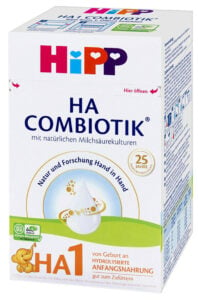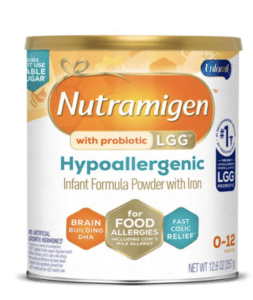Health
Hipp HA Vs. Nutramigen: Which HA Formula Is Better?

This post may contain affiliate links. As an Amazon Associate, I earn from qualifying purchases. Please read my disclosure.
If you’re looking for a hypoallergenic formula for your baby, you’ve likely come across two popular options: HiPP HA vs. Nutramigen. In this parent-friendly guide, I will explore these two infant formula options, outlining their differences, the pros and cons of each, and what to consider when choosing between these two formulas for your baby.
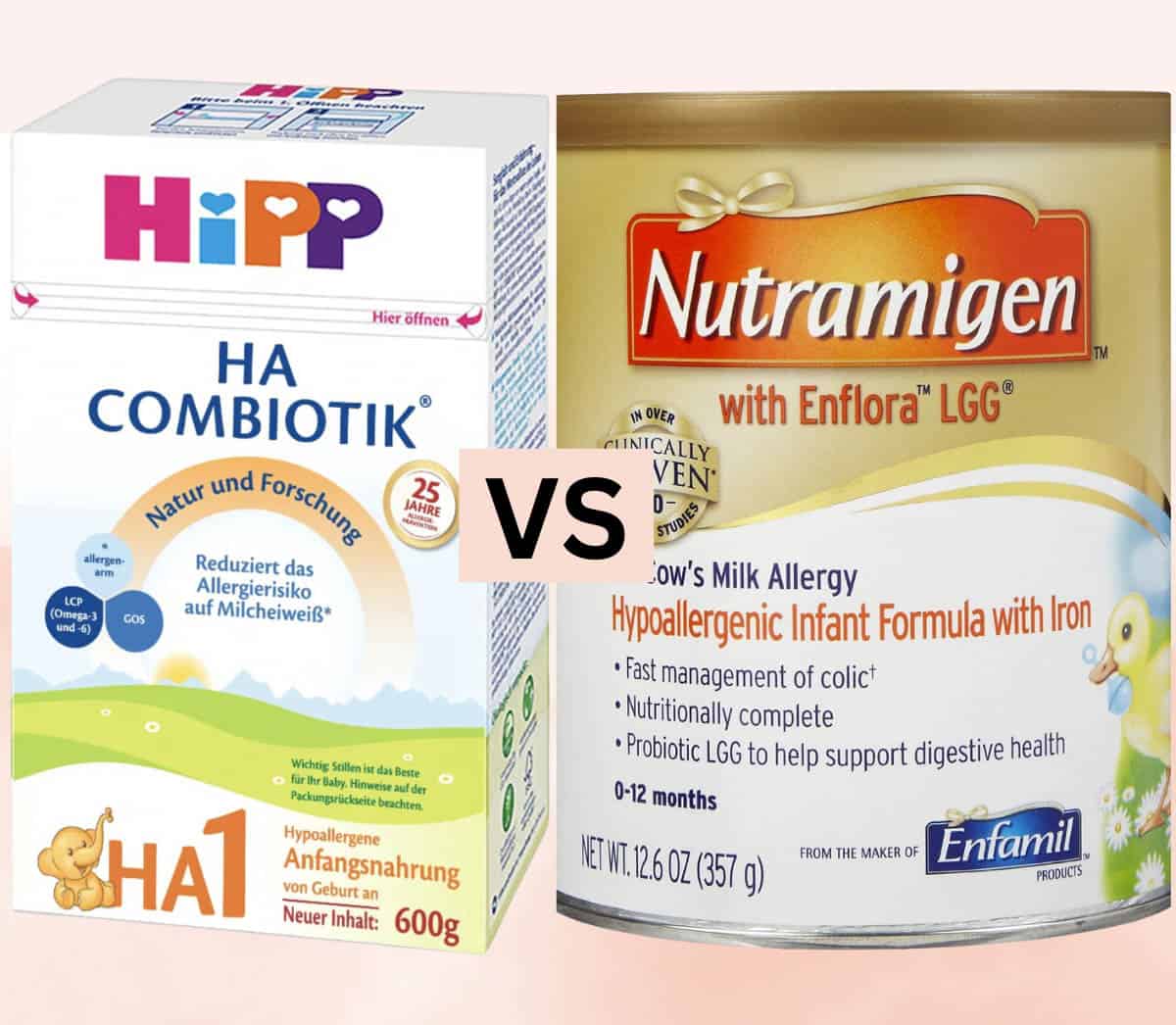

If you’ve been searching for a hypoallergenic formula, your baby likely has already shown some of the signs of needing an HA formula: discomfort when eating, reflux, gas, constipation, and more – all of which can be so stressful to deal with!
I’ve heard from many of you that my guide to the best hypoallergenic formulas has made it easier to choose between all of the options out there, but that figuring out whether HiPP HA or Nutramigen is the right choice can be daunting!
I was lucky enough to have two kids who didn’t have any allergies, but I have talked to so many parents who are confused about how to pick between HiPP HA and Nutramigen because they’re not exactly an apples-to-apples comparison. So that’s why I created this guide, based on my extensive knowledge as a parent, certified health coach and nutritionist, and hundreds of hours working with families and researching infant formula. Let’s dive in!
HiPP HA, a European baby formula brand free of added sugar and syrup solids, is a healthy, cost-effective alternative to Nutramigen if your baby has a cow’s milk protein sensitivity or a milder cow’s milk allergy.
Nutramigen, a US-manufactured formula, contains up to 47% syrup solids and can be more expensive than HiPP HA, but may be more suitable for babies with severe diagnosed CMPA. Note: Nutramigen was recalled in December 2023 for dangerous bacteria (source).
A Disclaimer & Methodology
As a board certified health coach and certified nutritionist, I support products and ingredients that are rooted in science and are evidence-based. Using my background in nutrition, along with extensive research (see below for details), consultations with experts, and my own personal experience giving my two kids formula, I have created this guide comparing HiPP HA and Nutramigen.
My recommendations are based on:
- Over 200 hours of extensive research
- Speaking with thousands of parents on what has worked for their children
- Reviewing both manufacturers’ claims and ingredients lists
- Speaking with doctors and pediatricians
- Reviewing countless articles and peer-reviewed studies
Though I may receive a commission (at no extra expense to you) if you purchase through some of the affiliate links provided, I only recommend products I’ve researched, evaluated, consulted experts on, and would feel comfortable giving to my own two children.
As always, I only share products that are the highest quality and that can help you and your family the most. By purchasing any of these products from the links below, you help keep this blog running, so thanks for your support!
Keep in mind that every baby & situation is different, so when it comes to choosing a baby formula, please consult with your pediatrician first before starting or switching to a new formula. My recommendations are not a substitute for professional medical advice, diagnosis, or treatment.
What Are Different Types Of Hypoallergenic Formula?
Let’s start by looking at the differences between hypoallergenic formulas and comparing the two popular brands, HiPP HA and Nutramigen.
Hypoallergenic baby formulas are specifically designed for infants allergic to cow’s milk or cow’s milk protein, commonly found in regular infant formulas.
These formulas are categorized into three types based on how their proteins are processed: partially hydrolyzed, extensively hydrolyzed, and amino acid-based.
Partially Hydrolyzed Formulas
Partially hydrolyzed formulas are designed with proteins that have been partially broken down, making them easier to digest for infants who may have trouble digesting whole proteins.
HiPP HA formula contains partially hydrolyzed whey protein, about 86-87% derived from organic skim milk.
Extensively Hydrolyzed Formulas
Extensively hydrolyzed formulas contain proteins that are extensively broken down into smaller pieces, which makes them less likely to trigger an allergic reaction.
Nutramigen is a formula that contains hydrolyzed casein protein from milk. At least 90% of the protein is broken down into smaller pieces.
Amino Acid-Based Formulas
Amino acid-based formulas are the least likely to cause an allergic reaction since they contain fully broken-down proteins into individual amino acids.
Neither HiPP HA nor Nutramigen meets this requirement.
When Should You Choose Hypoallergenic Formula For Your Baby?
If your baby shows a sensitivity or allergy to cow’s milk protein, such as colic, reflux, gas, other digestive issues, or eczema, I recommend talking to your pediatrician to see if switching to a hypoallergenic formula may help.
Hypoallergenic formulas may help ease the symptoms of a milk protein allergy or sensitivity, because, as mentioned above, they’re made with hydrolyzed proteins, which are broken down into smaller pieces that are less likely to trigger an allergic reaction.
In both the United States and Europe, parents have access to a variety of hypoallergenic formulas for infant nutrition. These formulas are designed to offer complete infant nutrition, including all the nutrients needed for healthy growth and development, while being gentle on your baby’s sensitive digestive system.


Comparing These Two Brands: Formula Overview
HiPP HA
HiPP HA Combiotic is a specialized infant formula for babies susceptible to the unique properties of cow’s milk proteins. These sensitivities can often lead to skin or digestive issues or hay fever-like symptoms, distressing both the baby and the parents.
This formula is designed to offer relief to such babies and contains hydrolyzed milk proteins that exclude casein, the protein typically responsible for allergic reactions. These hydrolyzed proteins are easier for infants to digest, making it an ideal choice for babies with digestive issues or who are prone to colic. (Learn More: Best Baby Formula For Colic).
In addition to hydrolyzed milk proteins, HiPP HA Stage Combiotic also contains Natural Lactic Acid Culture (Lactobacillus Fermentum Hereditum®²), which helps to improve gut health and boost the immune system. The formula also includes a perfect balance of proteins, vitamins, minerals, ARA (Omega-6), and DHA (Omega-3), ensuring that your baby receives all the necessary nutrients for healthy growth and development.
Partially hydrolyzed milk proteins
Contains prebiotics & probiotics
Contains mostly organic or biodynamic ingredients
Not extensively hydrolyzed, so may not work for severe allergies
Contains the same amount of lactose as a regular formula, so may not work for babies with a lactose intolerance
Enfamil Nutramigen
Nutramigen with LGG® is a specialized formula for infants with diagnosed mild to moderate cow’s milk protein allergies. It undergoes extensive hydrolysis and is expertly crafted to prevent allergic reactions in most infants. This formula provides a hypoallergenic solution for parents who seek a safe dietary option for their infants without compromising on the essential nutrients required for growth and development.
It comes in two formulations – a powdered version and a shelf-stable, liquid version. The key difference between the two is that the powdered version has a higher amount of added sugar and syrup solids (47%), while the liquid version a much lower amount of syrup solids (5%), but it contains carrageenan, which may cause inflammation in the body (source).
Nutramigen can be a reliable solution for families to manage CMPA and to reduce colic and gas in their infants.
Extensively hydrolyzed and hypoallergenic, suitable for lactose sensitivities and cow’s milk protein allergies
Includes LGG: An extensively studied probiotic for allergy management and supporting the digestive health of your baby
One stage for babies 0-12 months
No carrageenan in the powdered version
Contains corn syrup solids (the first ingredient, and is 47% of the formula in the powdered version)
Contains added starch (4% of the formula)
Contains palm oil and soy oil
Brand Reputation: Enfamil Nutramigen Vs. HiPP HA
Nutramigen Reputation
Nutramigen is a baby formula manufactured by Enfamil, a well-known and respected brand in the industry. It has been around since 1942 – that’s 82 years! Because it’s manufactured in the US, it is also regulated by the FDA. This formula is hypoallergenic and specifically designed to manage colic, resulting from a cow’s milk protein allergy. Relief is promised within 48 hours.
Nutramigen has always had a good reputation in the United States as being a reputable brand, whose formulas that can reduce and manage cow’s milk protein allergy symptoms.
However, in December 2023, thousands of cans of Nutramigen had to be recalled due to Cronobacter sakazakii, a bacteria that can cause severe infections. This is the second time in less than a year that the manufacturer, Reckitt/Mead Johnson Nutrition, has had to recall their product (source).
Since there is already a significant shortage of baby formula (source), these recalls are causing families to be concerned about the oversight in the formula industry. You can find more information about the recall on the company’s website at enfamil.com.
HiPP HA Reputation
HiPP is a well-known and respected European brand with over 50 years of experience producing high-quality organic baby formula. It is widely recognized for its commitment to sustainable farming practices and using only the finest ingredients that meet the highest organic standards. HiPP has built a loyal following among parents seeking a healthier alternative to conventional baby formulas.
Their extensive range of products includes various infant milk formula options and a variety of complementary foods for babies and toddlers. All are carefully formulated to provide optimal nutrition for infants and young children.
The HiPP HA line is a specialized formula for babies’ sensitivities to milk proteins. This formula is made with hydrolyzed protein, which makes it easier for babies to digest and has been clinically proven to reduce allergy symptoms. The HiPP HA line has received many positive reviews from parents who have seen significant improvements in their babies’ digestion and allergy symptoms.
Hipp HA: This well-established brand has over 50 years of experience and is known for its organic formulas, high-quality ingredients, sustainable farming practices, and positive reviews for sensitive babies.
Nutramigen: This brand has over 80 years of experience, is FDA-regulated, and is manufactured by Enfamil. It’s clinically designed to manage the symptoms of cow’s milk protein allergy. Unfortunately there has been more than one recall due to harmful bacteria.
HiPP HA Vs. Nutramigen: Nutrition
Let’s take a look at how HiPP HA and Nutramigen compare when it comes to their ingredients and nutrition. I’m going to review both of these formulas’ protein content, carbohydrate source, the types of fats used, and whether any other special ingredients (probiotics, prebiotics, etc.) are included.
Protein Content
As mentioned above, if a baby has an allergy or sensitivity to cow’s milk protein, they can be given partially or extensively hydrolyzed formulas. Hydrolysis involves breaking down the proteins into smaller components or peptides. The degree of hydrolysis determines whether a formula is partially or extensively hydrolyzed.
Hipp HA
Hipp HA is a formula that contains partially hydrolyzed whey protein derived from organic skim milk. The partial hydrolysis process breaks down around 86-87% of cows’ milk proteins.
Nutramigen
Nutramigen features extensively hydrolyzed casein protein derived from milk. The extensive hydrolyzation process breaks down over 90% of the cow’s milk proteins.
Carbohydrate Content
Many baby formulas contain lactose and/or corn syrup as the primary carbohydrate, but it’s important to note that not all carbohydrates are the same. Lactose is a natural sugar in milk. But corn syrup is a sweetener from corn starch, essentially added sugar.
Although lactose and corn syrup can provide energy for babies to grow and develop, lactose is the preferred carbohydrate source for infant nutrition. This is because it’s the primary carb source in breast milk, easily digestible, and provides a steady energy supply.
Conversely, corn syrup is a highly processed sweetener that, while safe in small amounts, may not be the best option for your baby. (Learn More: Corn Syrup In Baby Formula).
The primary carbohydrate source in HiPP HA is lactose, similar to the one found in breast milk. As a result, HiPP HA closely mimics the natural composition of breast milk and provides an easily digestible carbohydrate source for babies.
Nutramigen relies on corn syrup solids as its primary carbohydrate source. This differs from the lactose found in breast milk and Hipp HA, but corn syrup solids can provide energy without aggravating potential sensitivities related to lactose intolerance.
However, this carb source does count as added sugars, and may impact your child’s eating habits in the future (source). Also, some studies have suggested that infants who received formula with corn syrup-based carbohydrates had a higher risk of additional adverse health impacts, but this research is still ongoing (source).
Fats And Oils
Breast milk and formula milk both contain fats, proteins, carbohydrates, and many other nutrients essential for the baby’s growth and development. Fat contributes almost half of the calories in breast milk and formula, providing the energy required for the baby’s development.
Hipp HA’s fat content is derived from organic vegetable oils, such as palm, rapeseed, and sunflower. These oils provide the essential fatty acids for optimal infant brain and eye development.
Nutramigen’s fat source combines non-organic vegetable oils, including palm olein, coconut, soy, and high-oleic sunflower.
Probiotics And Prebiotics
Prebiotics are non-digestible food fibers that stimulate the growth of good bacteria in your baby’s gut. (Learn More: Prebiotics For Kids). At the same time, probiotics are live microorganisms that provide health benefits when consumed in adequate amounts. (Learn More: Probiotics For Baby Constipation).
Hipp HA
Hipp HA formula has a special ingredient called galactooligosaccharides (GOS), which are prebiotic fibers similar to those found in breast milk. These fibers help promote the growth of good gut bacteria, which in turn helps maintain balanced gut flora.
The Hipp HA formula also contains a natural probiotic lactic acid culture called Lactobacillus fermentum, initially extracted from breast milk. Combining prebiotics and probiotics helps support the baby’s immune system and digestion, keeping your little one healthy.
Nutramigen
Nutramigen is more effective than other extensively hydrolyzed protein formulas because it contains LGG® (Lactobacillus rhamnosus GG), the most researched probiotic for managing allergies in infants. LGG® helps to manage cow’s milk protein allergy and promotes the growth of a balanced gut flora that enhances immune health. Nutramigen doesn’t contain prebiotics.
HiPP HA is a nutritionally complete formula for infants that is made with organic ingredients. It uses lactose as its primary carbohydrate and contains no corn syrup solids. It has 86-87% hydrolyzed milk proteins and uses organic vegetable oils as its fat source. It contains both prebiotics and probiotics.
Nutramigen is also nutritionally complete for babies. It uses corn syrup solids as its primary carbohydrate source and is lactose-free. It has 90% hydrolyzed milk proteins, and uses non-organic vegetable oils as its fat source. It contains probiotics, it does not contain prebiotics. It does not contain organic ingredients.
Cost: HiPP HA Vs. Nutramigen
In my research, I’ve found that most hypoallergenic formulas are more expensive than their standard formula counterparts, primarily due to the specialized ingredients needed for these formulas.
When it comes to the cost of Hipp HA and Nutramigen, HiPP HA is the more affordable choice. Hipp HA is typically around $2 per ounce. On the other hand, Nutramigen may cost more, at around $3 per ounce.
Formula Availability
HiPP HA Availability
While HiPP HA is made in Europe, there are many reputable distributors of this formula that will ship to the US! I have reviewed many of these distributors and have found that this European baby formula website – TheMilkyBox – is a reliable source to purchase from, and HiPP HA is always available on their website.
I personally ordered from them and loved the convenience of having HiPP delivered straight to my doorstep in all stages. I felt relieved that it was so easy to get formula, knowing my baby’s nutritional needs were well taken care of without leaving the comfort of my home.
Nutramigen Availability
Nutramigen can be purchased through traditional retail channels in the United States and is available at Amazon, Target, and Walmart. However, due to the shutdown of the largest Abbott plant in the country in 2022 and subsequent bacterial contamination, Nutramigen may be less readily available and is sometimes out of stock.
Both HiPP HA and Nutramigen can be found online, and Nutramigen can be found in select stores in the United States as well. HiPP HA is slightly cheaper than Nutramigen.
HiPP HA is always readily available, and has had no issues with recalls or being out of stock. Nutramigen has had issues with recalls and is sometimes out of stock, making it harder to find at times.
Summary: Differences Between HiPP HA Vs. Nutramigen
| HiPP HA | Nutramigen | |
|---|---|---|
| Origin | Germany | United States |
| Manufacturer | HiPP Organic | Enfamil |
| Overview | Comes in 3 stages, only available as a powdered version. Regulated by the European Union. | Only 1 stage, available as either a powdered or liquid (ready-to-feed) version. Regulated by the FDA. |
| Brand Reputation | 50 years of experience. Is known for its organic formulas, sustainable farming practices, high quality ingredients, and positive reviews for sensitive babies. | 80+ years of experience, well known sensitive formula brand. Unfortunately, there have been more than one recall due to harmful bacteria. |
| Primary Protein Source | Partially hydrolyzed whey protein from organic skim milk (86-87%) | Extensively hydrolyzed casein protein from milk (90%+) |
| Carbohydrate Content | Lactose from milk | Corn syrup solids |
| Carbohydrate Benefits | Gentle on baby’s tummy, closer to breastmilk composition | Suitable for babies with lactose intolerance and diagnosed CMPA |
| Fats and Oils | Organic vegetable oils including palm, rapeseed, and sunflower | Non-organic vegetable oils including palm olein, coconut, soy, and high oleic sunflower |
| Prebiotics and Probiotics | Contains galactooligosaccharides (GOS) and probiotic Lactobacillus fermentum | Contains LGG® probiotic |
| Price Per Ounce | Approximately $2 | Approximately $3 |
| Availability | Easily found at TheMilkyBox.com and delivered to your door, always in stock. | Available to purchase on Amazon, Target, and Walmart, but has had issues with being out of stock due to formula shortages and recalls. |
FAQ’s
Check out this quick guide to help get your family started on switching baby formula.
Hypoallergenic formulas can start to relieve symptoms as quickly as 48 hours, with most babies finding the most comfort within 2-3 weeks.
The answer is, it depends on the needs of your baby! If your baby has a mild or moderate allergy or sensitivity, no lactose allergy, and you’re looking for a more affordable formula with organic ingredients and no corn syrup solids, then I would recommend trying HiPP HA first. But if your baby is allergic to lactose and / or has a severe cow’s milk protein allergy, Nutramigen might be the better choice.
Final Thoughts
Hydrolyzed protein formulas are all different, but HiPP HA and Nutramigen are two of the more popular options. Both have pros and cons, and depending on what your baby’s specific allergies are, either can be the right choice.
Personally, if my baby had a cow’s milk sensitivity or a moderate allergy, I would choose HiPP HA because it has a stronger brand reputation, is more affordable, has higher quality, organic ingredients, and no corn syrup solids.
However, if my baby had a severe lactose allergy or severe CMPA, HiPP HA may not be broken down enough, and I may have no choice but to use Nutramigen, which is designed for babies with more severe allergies.
Regardless, if your baby has a sensitive digestive system or is showing signs of allergies, I would recommend that you talk to your child’s pediatrician about choosing a formula that contains hydrolyzed protein.
Health
The Hazards and Blessings of Being Male: Embracing the Seven Challenges For a Successful Life

Although there have been infinite varieties of life forms that have evolved on Earth in the last 4 billion years, two life forms that are our male and female ancestors evolved a billion years ago. Here’s how this first sexual experience occurred according to cosmologist Dr. Brian Swimme and historian Dr. Thomas Berry in their book, The Universe Story.
The first male organism—they call him Tristan—and the first female organism—they call her Iseult—began life in the ancient oceans. Swimme and Berry describe their chance encounter this way:
“They were cast into the marine adventure, with its traumas of starvation and of predation. Able to nourish themselves but no longer capable of dividing into daughter cells, such primal living beings made their way through life until an almost certain death ended their 3-billion-year lineage.
A slight, an ever so slight, chance existed that a Tristan cell would come upon a corresponding Iseult cell.They would brush against each other, a contact similar to so many trillions of other encounters in their oceanic adventure. But with this one, something new would awaken. Something unsuspected and powerful and intelligent, as if they had drunk a magical elixir, would enter the flow of electricity through each organism.
Suddenly the very chemistry of their cell membranes would begin to change. Interactions evoked by newly functioning segments of her DNA would restructure the molecular web of Iseult’s skin, so that an act she had never experienced or planned for would begin to take place—Tristan entering her cell wholly.”
Of course no humans were there to record this original encounter, but we all have origin stories and this one resonates with me. Dates are never exact and change as more information is gathered. Here are some additional dates I found important in The Universe Story timeline:
- 12 billion years ago, the universe begins.
- 4 billion years ago life first emerges.
- 1 billion years ago sexual reproduction evolves.
- 216 million years ago the first mammals appear.
- 30 million years ago the first apes inhabit the earth.
- 2.6 million years ago the first humans appeared.
- 200,000 years ago Archaic Homo sapiens evolved.
- 10,600 years ago first settlements in the Middle East emerged and wheat and barley were cultivated.
Needless to say, we have a long evolutionary history to embrace. In their book, Solving Modern Problems with a Stone-Age Brain, Douglas T. Kenrick, PhD and David E. Lundberg-Kenrick describe seven evolutionary challenges we must all face and embrace. They offer a visual summary as a revision of Maslow’s original Hierarchy of Human Needs which they call The New Pyramid of Human Motives:

The Seven Challenges for a Successful Life
During the billion years of life, all organisms must embrace these challenges and they are particularly relevant beginning with our mammalian history. In their book, the Kenricks ask, “What are the fundamental problems of human existence?” They go on to share the results of their research.
“Together with a large team of researchers at more than 30 universities on five continents, we have been investigating the universal motivations faced by human beings around the globe.”
Here is a summary of their findings:
We must meet our basic physiological needs for shelter from the elements,
water, and food.
- Protect yourself from attackers and plunderers.
Given the scarcity of resources and the ever-present possibility of starvation, there has always been competition among different groups (most often the male members) for precious real estate and resources (including access to females).
As the Kenricks remind us. “Our ancestors were not rugged individualists.
They need to band together not only to protect themselves from bands of
marauding bad guys but also to accomplish most of the tasks of everyday life.”
Some people have always been more resourceful and clever than others and
some were more willing to bravely defend their groups against armed marauders.
Those resourceful and courageous individuals won higher status and gained
greater respect.
“From the perspective of evolution by natural selection,” say the Kenricks, “this
step is essential. Every one of our ancestors managed to attract at least one
person who wanted to make with them. Not everybody in the ancient world got
to reproduce, though, and a reasonable percentage of men went unmated.” This
fact, is of major importance when understanding male desires, fears, and
behavior.
From an evolutionary perspective, we not only have to find a mate who will have
sex with us, but we need to hold on to our mate long enough to have a child and
raise the child to maturity, so they can find a mate and continue the process.
- Care for your family members.
Unlike other animals, human males are much more involved with raising children, since human children require long-term care before they reach reproductive age.
Males and Females Are Alike and Also Different
Males and females are alike in that they must both successfully meet the seven challenges noted above. However, there are also significant evolutionary differences. These differences first came home to me when I first met psychologist David M. Buss and read his book, The Evolution of Desire: Strategies of Human Mating.
“If mating desires and other features of human psychology are products of our evolutionary history,” says Dr. Buss, “they should be found universally, not just in the United States.”
To test his theories, he conducted a five-year study working with collaborators from thirty-seven cultures located on six continents and five islands. All major racial groups, religious groups, and ethnic groups were represented. In all, his research team surveyed 10,047 persons world-wide.
Dr. Buss concluded that there are actually two human natures, one male, the other female. What do women really want? Buss found that the top three qualities that women look for in men are exactly the same as those things that men look for in women: Intelligence, kindness, and love. Then, what women want diverges from what men want.
“Women then look at a man’s ability to protect her and her children, his capacity to provide, and his willingness to make commitment to a relationship,” says Buss.
What do men really want?
“A man is drawn to youth and beauty,”
says Buss.
“This interest is not just a modern desire driven by advertising and male desire to control women [though advertisers take advantage of our evolutionary-driven desires]. It is a universal desire based on evolutionary pressures for reproductive success. Men who mated with women who were incapable of bearing children left no ancestors. Every man alive today is descended from men who did not make that mistake. Worldwide, men are drawn to younger women.”
Note: Just because we have these evolutionary-based desires does not mean we must act on them, that they are good for us, or will make us, or the partners we desire, happy. It also does not mean they are hard-wired into our biological makeup and can’t be changed. It does mean that we must take seriously our evolutionary-based desires and listen to the ancient “whisperings within” that pull us in certain directions.
The Hazards and Blessings of Gender-Specific Health
The ancient Roman philosopher, Virgil offers a simple truth to consider.
“The greatest wealth is health.”
A modern American medical doctor, Marianne J. Legato, M.D., world-renowned cardiologist and founder of The Foundation For Gender-Specific Medicine, says,
“The premature death of men is the most important—and neglected—health issue of our time.”
Although human males, as a group, occupy more positions of power in government and business than women, it has come at a price. This was first brought home to me by psychologist Herb Goldberg, in his book 1976, The Hazards of Being Male.
“The male has paid a heavy price for his masculine ‘privilege’ and power. He is out of touch with his emotions and his body. He is playing by the rules of the male game plan and with lemming-like purpose he is destroying himself—emotionally, psychologically and physically.”
In recent years we have learned a lot more about the realities of being male.
“If it’s true that men rule the world, it comes at a heavy cost,”
says Dr. Legato.
“From conception until death, men are inherently more fragile and vulnerable than women. In virtually every society today, men die first.”
Dr. Legato offers the following facts of life:
- The male fetus is less likely to survive the womb than the female.
- Boys are six weeks behind in developmental maturity at birth compared to girls.
- Men have four times the developmental disabilities of females.
- Men suffer more severely than women from seven of the ten most common infections that human experience [Including Covid-19].
- Men are likely to experience the first ravages of coronary artery disease in their mid-thirties, a full 15 or 20 years before women.
- Twice as many men die of heart disease, the leading cause of all deaths, than do women.
- Men die by suicide 4 times more than women.
- Murder and homicide are among the top four killers of men from the time they are born until heart disease and cancers begin to claim those who survive into middle age.
Accepting the realities of our own inherent weakness and vulnerabilities instead of trying to pretend we are masters of the universe is the first step we just take to begin our own healing and recovery.
I have been writing a series of articles on the Future of Men’s Mental Health. In Part 3, “Gender-Specific Healing and Man Therapy,” I explore my own healing journey and issues that address the unique problems faced by men and how the emerging field of Gender-Specific Healing and Men’s Health is a key to the future of health care. If you’d like more information about upcoming trainings, drop me an email to Jed@MenAlive.com and put “Gender-Specific Health Training” in the subject line.
Health
Healthy No-Bake Peanut Butter Bliss Balls

This post may contain affiliate links. As an Amazon Associate, I earn from qualifying purchases. Please read my disclosure.
My no-bake, healthy peanut butter bliss balls are loaded with creamy peanut butter and chocolate flavor, making them a hit with both kids and adults alike. Enjoy these as an on-the-go breakfast, wholesome snack, or healthy dessert alternative! They’re also dairy-free, vegan, gluten-free, and low in sugar, making them ideal for a variety of dietary preferences.
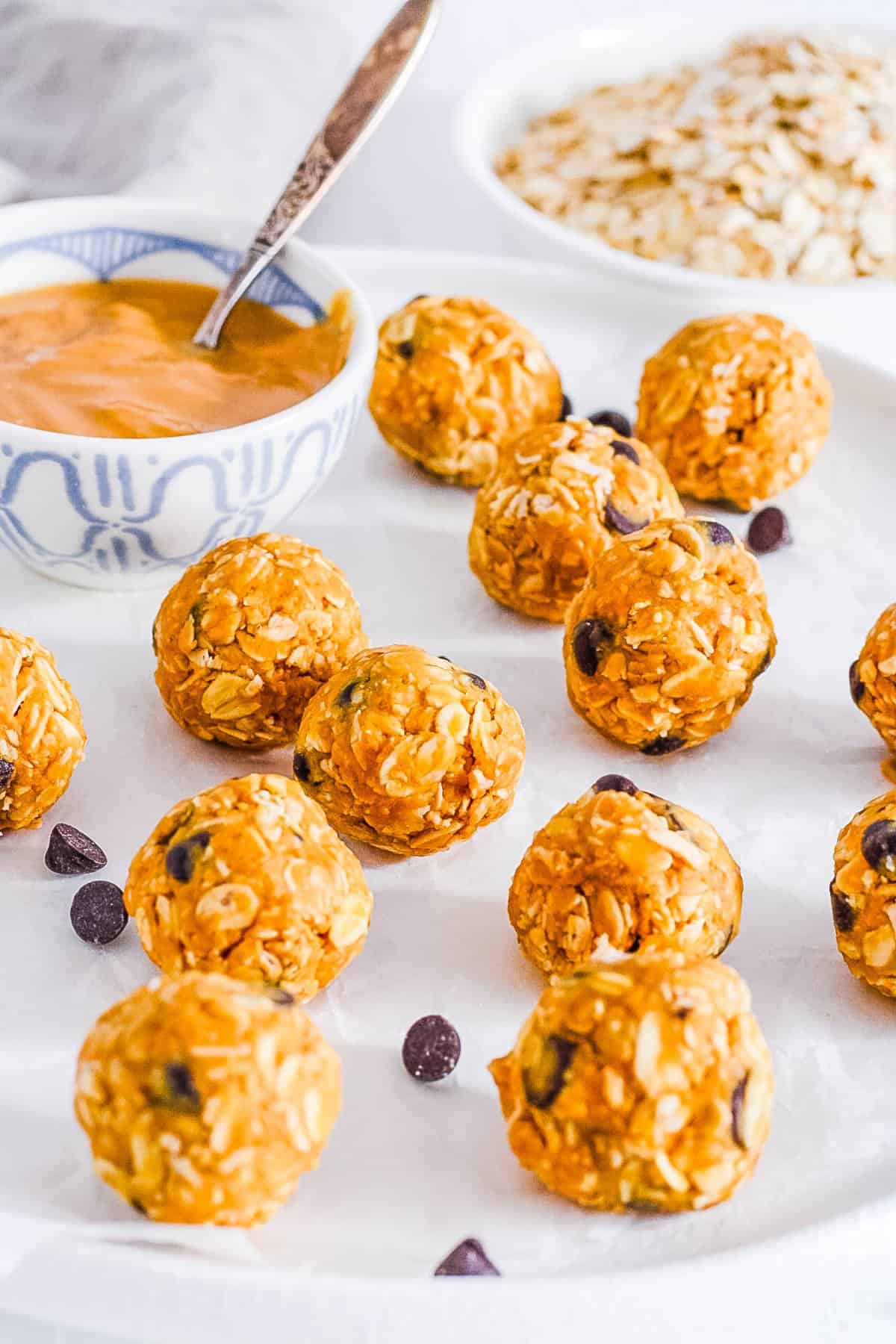
Indulge in my delicious no-bake peanut butter bliss balls, affectionately called “cookie dough bites” by my daughter. They taste like dessert, but are totally guilt-free and nutrient-rich! I love bliss ball recipes like this one because they come together quickly, and always satisfy my sweet tooth!
With only five simple ingredients and just ten minutes of prep time, bliss balls are a perfect option for busy days. I especially love making a huge batch at the beginning of the week, and enjoying them all week long for ultimate convenience. I find that they taste even better the next day, once they’ve had time to chill in the fridge for a while longer!
These protein balls with peanut butter are such a fun treat for any time of day! I really love how versatile they are – I’ll often use them as part of a quick breakfast, for packing in my kids’ lunches, or as a mid-afternoon snack.
Made with natural peanut butter, hearty oats, and a touch of pure maple syrup, I’ve crafted these bliss balls to be as healthy as possible. You won’t find any refined sugar here, even with these healthy swaps they still taste just like cookie dough. And each ball has only 90 calories and 3 grams of sugar!
I’ve also made sure that these wholesome ingredients can come together with minimal equipment required. No need to deal with your bulky food processor and spend all that extra time cleaning!
And my all time favorite thing about this recipe is that it’s a great way to involve kids in the kitchen. My kids have so much fun helping me out and adding in their own special twists.
Your family can also customize them in so many different ways, changing things up based on your preferences! I’ll share my favorite variations later in this post (like my peanut butter bliss balls with protein powder)!
Latest Recipe Video!
🥘 Ingredients
My easy peanut butter bliss balls recipe calls for just 5 nutritious ingredients, all easily found in your pantry or local grocery store. Here’s what you need:
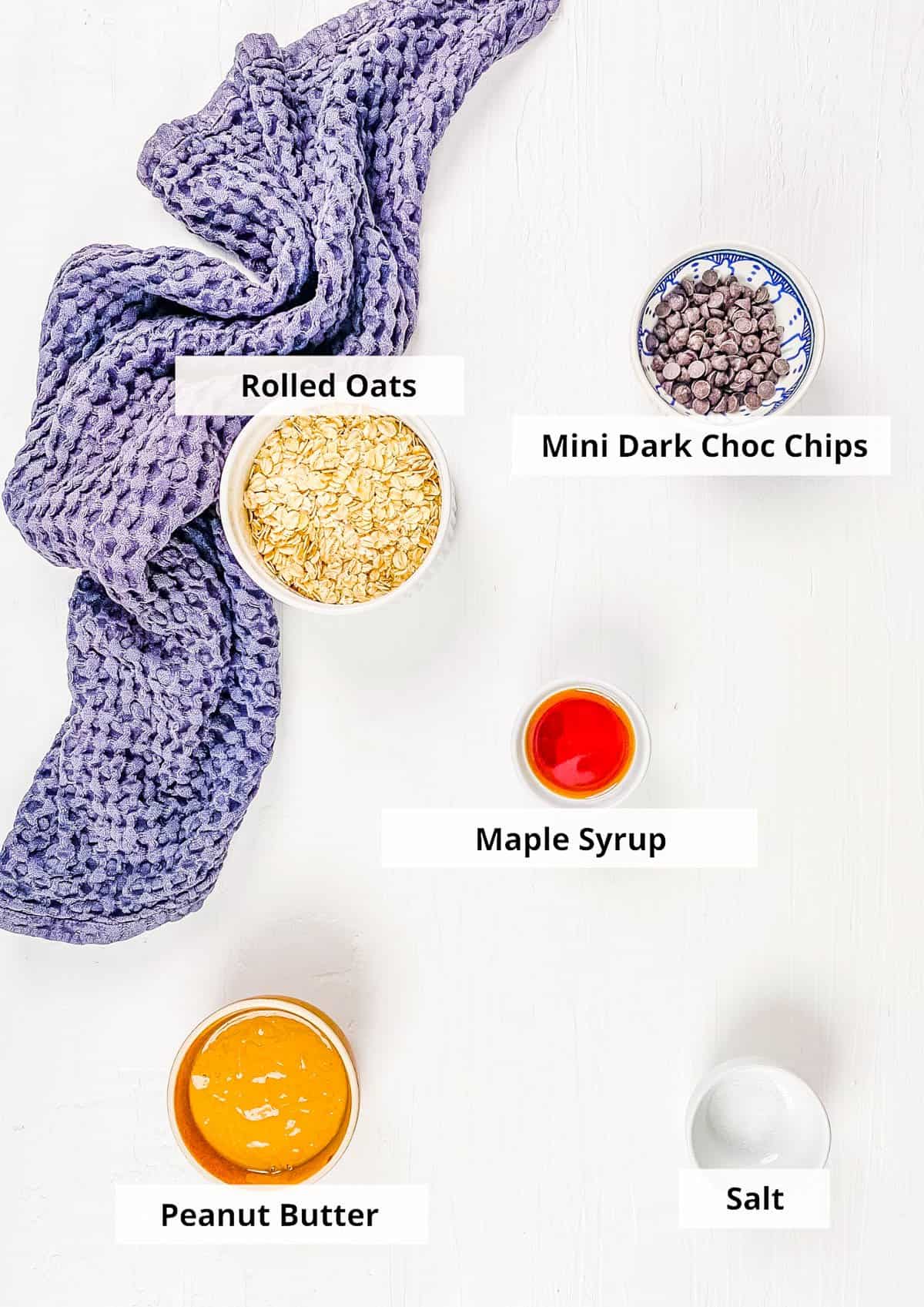
Oats: I’ve found that rolled oats work best for these kid-friendly bliss balls. I don’t recommend using oat flour or quick oats as it won’t have the same texture as whole oats, and won’t hold up as well.
Natural Peanut Butter: I use creamy peanut butter to bind all the ingredients together and add a boost of protein to these energy bites. If you don’t have peanut butter, try almond butter as a 1:1 substitute. Other nut butters (like cashew butter or a mixed nut butter) should also work in place of peanut butter, but the bites might have a slightly different consistency since some nuts create a thinner or runnier butter than others!
Dark Chocolate Chips: I prefer using dark chocolate chips for a healthier choice. These can be regular or mini chocolate chips. To keep this recipe vegan-friendly, I’ll use dairy-free chocolate chips. If you don’t need these to be vegan, then semisweet, white chocolate, or milk chocolate chips are all yummy options.
Maple Syrup: The only added sugar is natural maple syrup which gives the bliss balls a slightly sweet taste. If you don’t have maple syrup on hand, agave, raw honey, or vegan honey work.
Vanilla Extract: Pure vanilla extract brings out the richness of the chocolate. Sometimes I also add a pinch of salt to really enhance the sweetness. For a nutty flavor, try using almond extract.
🔪 How To Make Peanut Butter Bliss Balls
My vegan no bake peanut butter balls are so easy to make – they’re ready in just 3 simple steps. Let me show you how to make these healthy dessert balls:
Combine Ingredients: In a large bowl, using a wooden spoon, I start by stirring together the oats, peanut butter, chocolate chips, maple syrup, vanilla, and salt until combined.
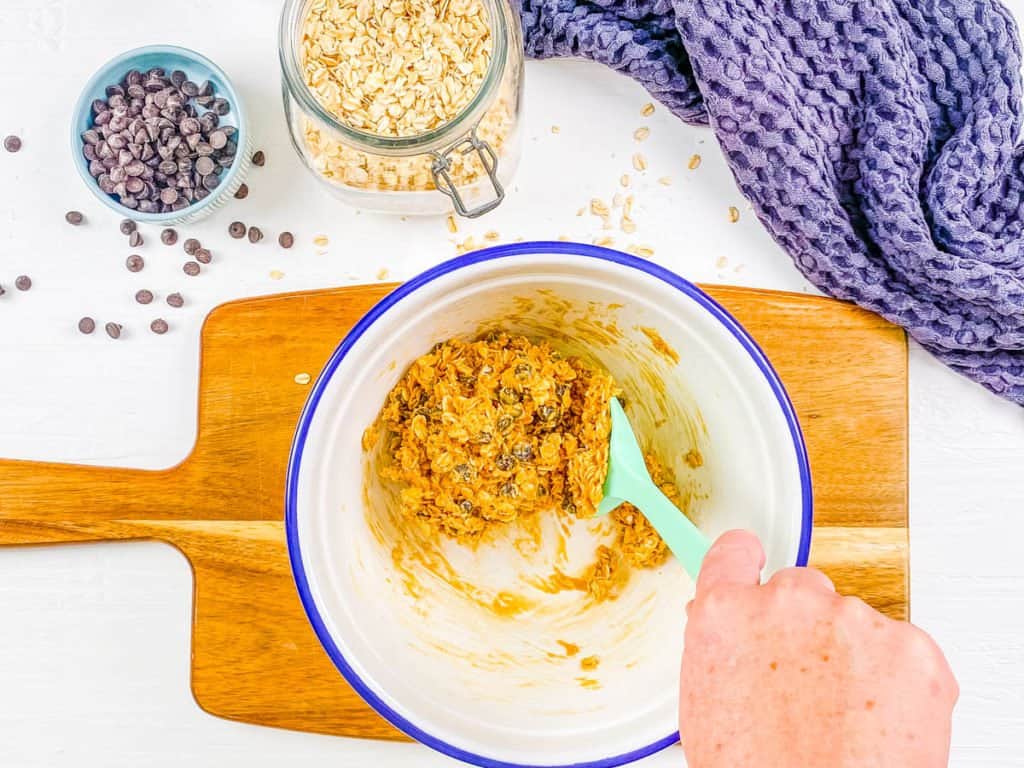
Form The Bliss Balls: Next, I line a baking sheet with parchment paper. Taking small handfuls of the mixture, I roll them into small balls 1-2 inches in size – about the size of a golf ball or ping pong ball. I prefer to use a cookie scoop to make this step extra easy. Place each ball onto the baking sheet.
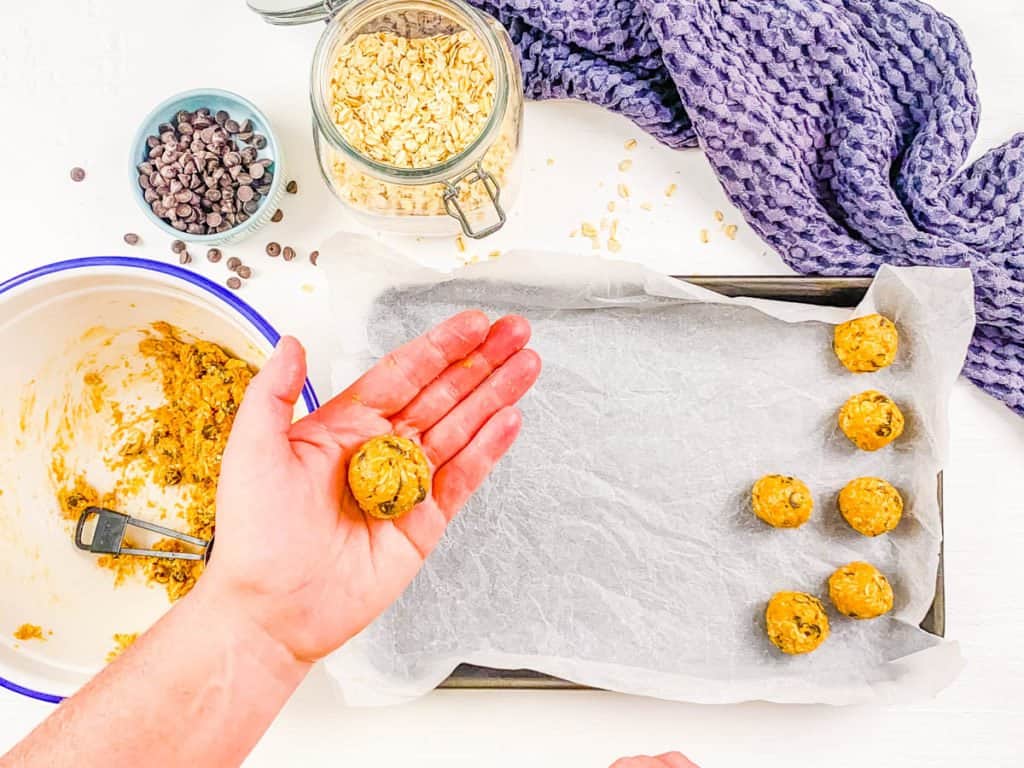
Let The Balls Set: Once rolled, I refrigerate these peanut butter snack balls for 30 minutes or until solid.
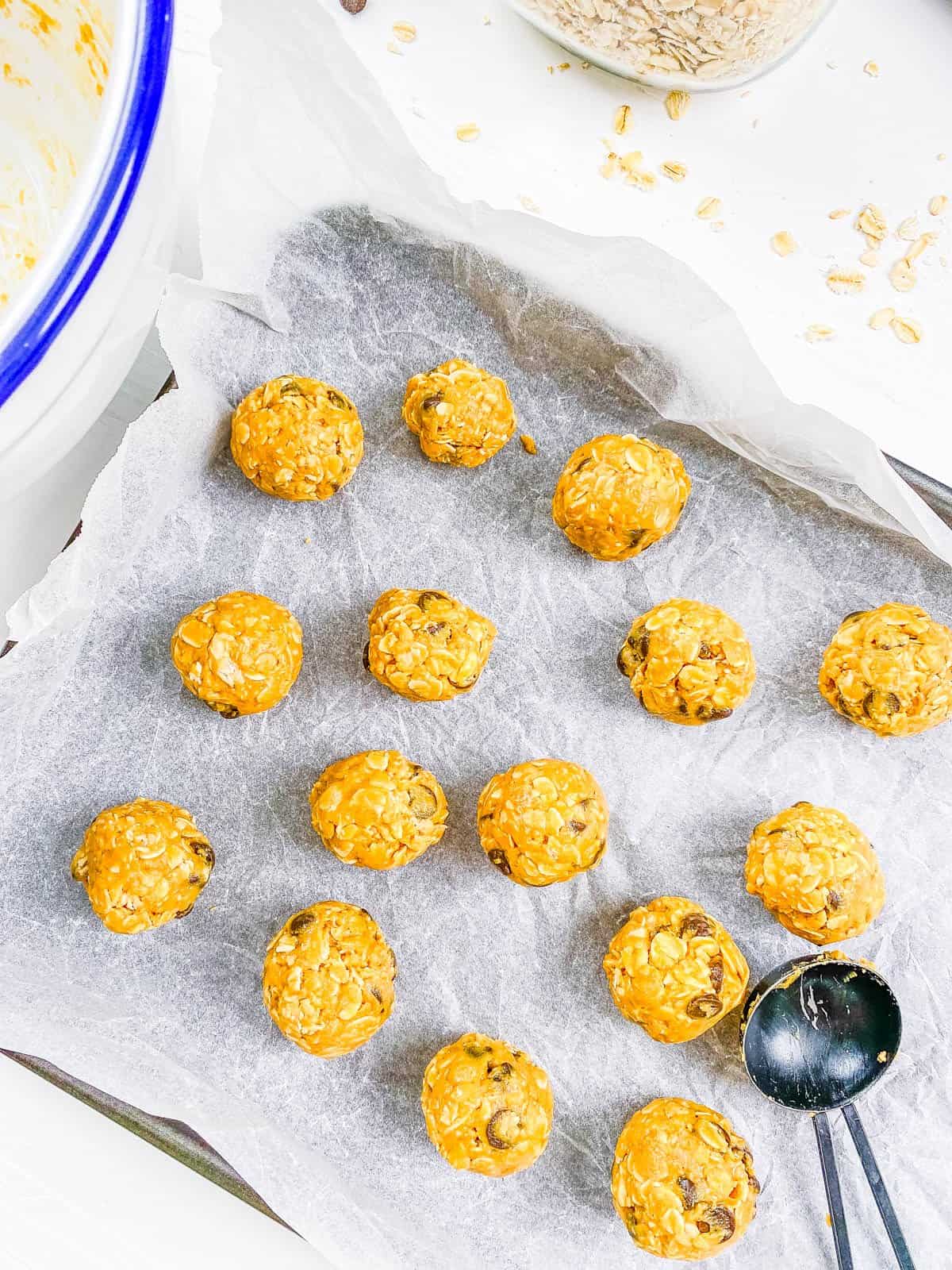
My #1 Secret Tip for this recipe is to make sure you measure ingredients precisely, with the right ratio of wet to dry ingredients.
While there is a little wiggle room with these bliss balls due to them being a no-bake recipe, I recommend being precise with all measurements to ensure ensures that the mixture has the right consistency to hold together without being too sticky or crumbly.
The creamy peanut butter is critical as the binding ingredient for these bliss balls, and I find it to be especially important to measure correctly. Too much or too little will throw the whole recipe off, leading to a mixture that is either too wet and sticky or too dry and crumbly.
After trial and error, I have found that achieving this balance is important for forming perfect bliss balls that stay intact and have a great texture.
Other Tips To Keep In Mind:
- Use The Right Tools: I like to use a cookie scoop to get all of these no-bake bliss balls the same size and to help my hands stay mess free!
- Check The Oats: If you or someone in your family is gluten intolerant, be sure to check the packaging on your oats for gluten-free certification. Some oats can be at risk for contamination with gluten substances.
- Involve The Kiddos: My kids love to help out in the kitchen, and this no-bake recipe is perfect for kids of all ages! They can learn how to measure out ingredients, combine ingredients, and roll the mixture into perfect ball shapes!
- Adjust For Moisture: If the dough seems too wet to mold into balls, consider adding a tablespoon or two of oat flour or almond flour. This will help to firm the mixture up so that it holds its shape and doesn’t stick to your hands.
- Bliss Balls For Kids: If you want to make these as toddler peanut butter balls I recommend reducing or omitting the sugar! You might also want to cut them into smaller bites when serving.
📖 Variations
I’ve perfected a few easy swaps and add-ins for when I’m looking to switch up the taste or texture a bit with these healthy kid-friendly bliss balls. There is something for any occasion! Here are my favorite variations:
Peanut Butter Protein Balls: If you want to turn these peanut butter protein bliss balls, consider adding a scoop of vegan vanilla protein powder to the batter before mixing it. You can use up to 2 scoops of protein powder, depending on the flavor of the protein powder you use. Sometimes I also add 1 tablespoon of ground chia seeds, flax seed, or hemp seeds for an extra boost of protein and healthy fats.
Chocolate Bliss Balls With Peanut Butter: For a double serving of chocolate, add a tablespoon of cacao or cocoa powder to the batter before mixing. I love the rich and indulgent flavor that this gives this recipe! I serve this as a healthy kids dessert often!
Peanut Butter Date Bliss Balls: For a sweeter flavor, I like to add a ¼ cup of Medjool dates, soaked and drained. I use a food processor when adding dates so that they are completely incorporated with the peanut butter and oats.
Sugar-Free Bliss Balls: If you want to make these no-bake peanut butter balls truly sugar-free, you can omit the maple syrup and use sugar-free chocolate. I think they still taste pretty good thanks to the natural sweetness from the vanilla and chocolate chips! If you are making these peanut butter balls for toddlers, this is a good option.
Mix-Ins: Add your favorite mix-ins to give these peanut butter energy balls some texture. I find that crushed walnuts, pecans, peanuts, sunflower seeds, and cacao nibs work really well in this recipe. My other favorites are dried fruit like cranberries, raisins, dried apricots, and shredded coconut. I also love adding spices like a pinch of sea salt, cinnamon powder, nutmeg, or pumpkin pie spice into the mixture. When making these as toddler protein balls, be mindful of the size of the nuts and dried fruit.
🍽 Serving Suggestions
While I love these healthy bliss balls with peanut butter on their own for an easy grab-and-go snack or healthy dessert, it can be so fun to get creative with other ways to serve these! Try some of these ideas:
Toppings: For a decadent dessert I love to drizzle chocolate sauce or caramel sauce (like the one on this no-bake salted caramel cheesecake) over these no bake snacks!
Ice Cream: My kids love to mix these no bake peanut butter dessert balls into tofu ice cream for a delicious treat.
Drinks: Energy balls can be found at a lot of coffee shops nowadays, so it only feels right to create those coffee shop vibes at home! I have been loving these balls with my oatmilk honey latte or iced ube latte! You can also do a creamy mixed berry smoothie alongside these protein balls for kids as an afternoon snack.
With Other Energy Bites: Make a spread of energy bites and serve these alongside my vegan protein balls, peanut butter date balls, and these homemade lara bars! I love this idea for parties and special occasions!
🫙 Storage Instructions
Room Temperature: I store these dairy free peanut butter balls in an airtight container at room temperature for up to 3 days.
To Refrigerate: After placing in an airtight container or resealable plastic bag, I’ll store these in the fridge for maximum freshness. They’ll be good for about one week!
Freezer: I don’t recommend storing these vegan energy balls in the freezer as they won’t taste as good when defrosted.
❓Recipe FAQs
The best type of peanut butter to use is natural peanut butter with no added sugars, oils, or preservatives. I recommend looking for a brand that has just one ingredient listed: peanuts. You can also use a brand that has peanuts and salt listed as the only two ingredients.
There are two ways I’d recommend adjusting this recipe if your mixture is too dry: 1) Add more peanut butter – it’ll help bind the ingredients and add moisture. 2) Add a little bit of coconut oil, maple syrup, or even a touch of applesauce – these ingredients will add moisture and flavor to your peanut butter oat balls!
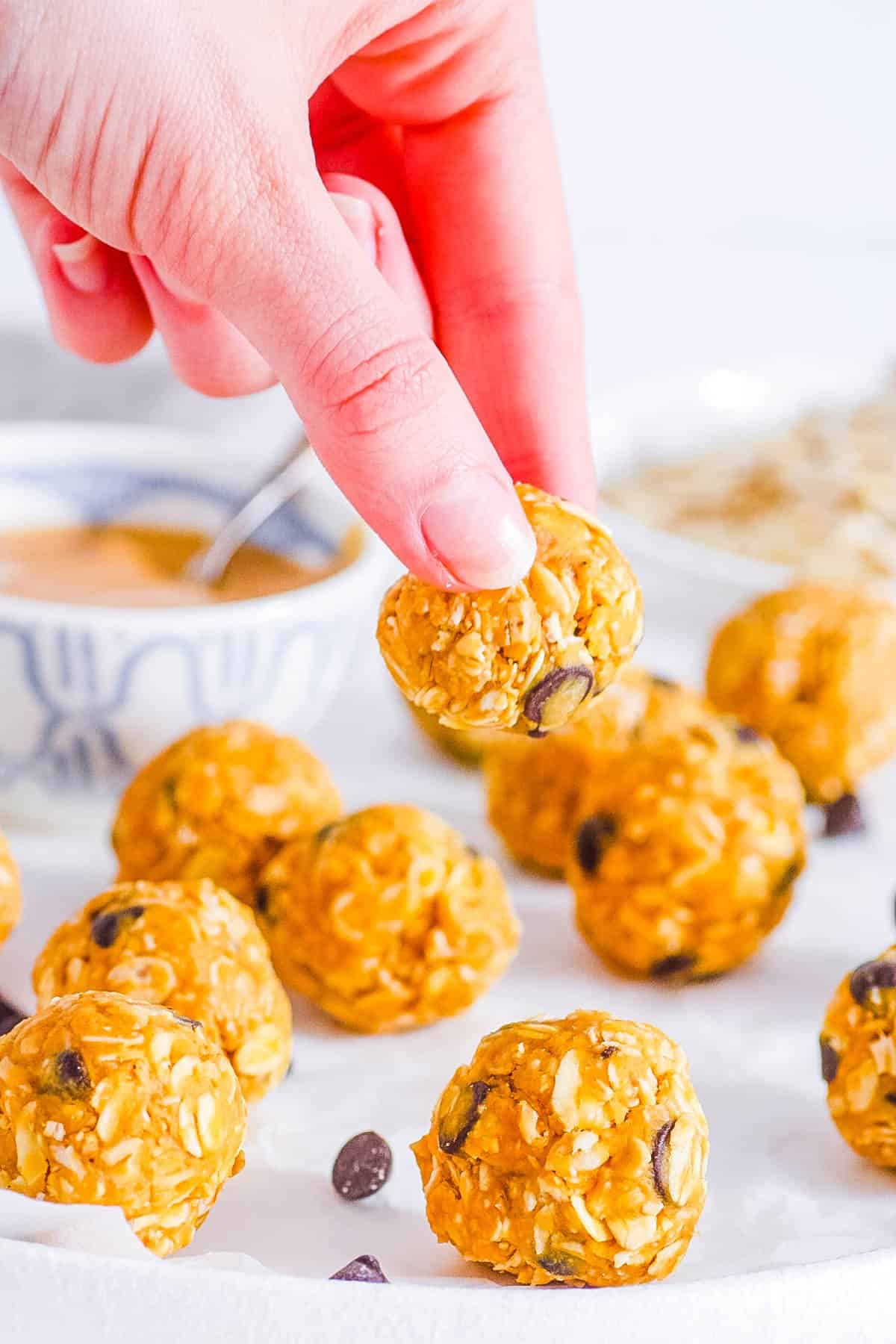
Want to Save This Recipe?
Enter your email & I’ll send it to your inbox. Plus, get great new recipes from me every week!
By submitting this form, you consent to receive emails from The Picky Eater.
Love this plant based dessert recipe? Please leave a 5-star rating 🌟 in the recipe below and/or a review in the comments section further down the page!
You can also FOLLOW ME on FACEBOOK, INSTAGRAM, and PINTEREST to see more delicious, healthy, family-friendly food, and if you have any questions, I’m here to help!
📋 Recipe Card
Healthy No-Bake Peanut Butter Bliss Balls
My healthy, easy no bake peanut butter bliss balls are loaded with creamy peanut butter and chocolate flavor, making them a hit with both kids and adults alike. Enjoy these as an on-the-go breakfast, wholesome snack, or healthy dessert alternative! They’re also dairy-free, vegan, gluten-free, and low in sugar, making them ideal for a variety of dietary preferences.
Servings: 16 balls
Calories: 93kcal
-
In a large bowl, using a wooden spoon, stir together the oats, peanut butter, chocolate chips, maple syrup, vanilla, salt (and protein powder, if using) until combined.
-
Line a baking sheet with parchment paper.
-
Taking small handfuls of the mixture, roll them into small balls 1-2 inches in size. Or you can use a cookie scoop. Place them onto the baking sheet.
-
Refrigerate the bites for 30 minutes or until solid. Store in an air-tight container in the fridge (they will last at least 1 week, and likely 2!)
- Use The Right Tools: Use a cookie scoop to get all of the balls the same size.
- Check The Oats: If you or someone in your family is gluten intolerant, be sure to use gluten-free oats.
- Involve The Kiddos: This is such a great no bake recipe for kids to make – get them in the kitchen!
- Adjust For Moisture: If the dough seems too wet to mold into balls, consider adding a tablespoon or two of almond flour.
- Sugar Free: If you want to make these truly sugar-free, you can omit the maple syrup, and they will still taste pretty good.
- Peanut-Free: Use your favorite alternative nut butter or seed-based butter.
- Nutritional information includes protein powder. Note: for even more protein, use 1 scoop of vegan vanilla protein powder and 1 scoop of peanut butter protein powder.
Serving: 1ball | Calories: 93kcal | Carbohydrates: 8g | Protein: 4g | Fat: 5g | Saturated Fat: 2g | Polyunsaturated Fat: 1g | Monounsaturated Fat: 2g | Cholesterol: 4mg | Sodium: 43mg | Potassium: 92mg | Fiber: 1g | Sugar: 3g
Health
Federal Experts Talk Bird Flu ‘What Ifs’ in WebMD Live Event

May 16, 2024 – Multiple U.S. agencies are working to contain the recent bird flu outbreak among cattle to prevent further spread to humans (beyond one case reported in early April) and use what we learned before, during, and after the COVID-19 pandemic to keep farm workers and the general public safe.
Fingers crossed, the bird flu will be contained and peter out. Or the outbreak could continue to spread among dairy cattle and other animals, threatening the health and livelihoods of farmers and others who work with livestock.
Or the virus could change in a way that makes it easier to infect and spread among people. If this happens, the worst-case scenario could be a new influenza pandemic.
With so many unknowns, WebMD brought together experts from four federal agencies to talk prevention, monitoring, and what the “what ifs” of bird flu might look like.
Communication with the public “about what we know, what we don’t know, and ways you and your family can stay safe is a priority for us at CDC,” said Nirav D. Shah, MD, JD, the CDC’s principal deputy director. “We at the federal level are responding, and we want the public to be following along.”
People should consult the websites for the CDC, FDA, U.S. Department of Agriculture (USDA), and the Administration for Strategic Preparedness and Response (ASPR) for updates.
It is essential to not only stay informed, but to seek trusted sources of information, Shah said during “Bird Flu 2024 – What You Need to Know,” an online briefing jointly sponsored by the CDC and WebMD.
An ‘Experimental Hamburger’
If one take-home message emerged from the event, it was that the threat to the general public remains low.
The retail milk supply is safe, although consuming raw or unpasteurized milk is not recommended. “While commercial milk supply is safe, we strongly advise against drinking raw milk,” said Donald A. Prater, DVM, acting director for the FDA’s Center for Food Safety and Applied Nutrition.
As for other foods, thoroughly cooked eggs are less risky than raw eggs, and the nation’s beef supply remains free of the virus as well.
For years, federal inspectors have purchased and tested meat at retail stores, said Eric Deeble, DVM, USDA deputy assistant secretary for the Office of Congressional Relations. So far, H5N1, the virus behind bird flu, has not been detected in beef.
The USDA took testing a step further and recently cooked ground beef from dairy cows in their lab. Using what Deeble described as an “experimental hamburger,” the agency showed cooking beef to 165 F or higher kills the virus if it ever becomes necessary.
The federal government now requires all cattle be tested and be free of bird flu virus before crossing any state lines. The government is also reimbursing farmers for veterinary care and loss of business related to the outbreak, and supply personal protective equipment (PPE) like gloves, masks, and face shields to workers.
Vaccination Not Recommended Now
Federal scientists know enough about H5N1 virus to create vaccines against it quickly if the need arises. It’s more about planning ahead at this point. “Vaccines are not part of our response right now,” said David Boucher, PhD, director of infectious diseases preparedness and response at the Administration for Strategic Preparedness and Response.
If the virus changes and becomes a bigger threat to people, “we have the building blocks to produce a vaccine,” Boucher added.
An event attendee asked if the seasonal flu shot offers any protection. “Unfortunately, the flu shot you got last year does not provide great protection from the avian flu,” Shah responded. “It might do a little bit … but that is the vaccine for seasonal flu. This is something more novel.”
Treatments Stockpiled and Ready
Antiviral medications, which if given early in the course of bird flu infection could shorten the severity or duration of illness, are available now, Shah said. The dairy farmer who was infected with bird flu earlier this year responded to oseltamivir (Tamiflu) treatment, for example.
When it comes to bird flu symptoms, the fact that the only infected person reported so far this year developed pink eye, also known as conjunctivitis, is interesting, Shah said. Officials would have expected to see more typical seasonal flu symptoms, he added.
“Influenza is not a new virus,” Boucher said. “With this strain of influenza, we are not seeing any genetic markers associated with resistance to antivirals. That means the antivirals we take for seasonal influenza would also be available if needed to treat H5N1.”
ASPR has stockpiled Tamiflu and three other antivirals. “We do have tens of millions of courses that can be distributed around the country if we need them,” he added.
“Influenza is an enemy we know well,” Boucher said. That is why “we have antivirals ready to go now and many types of PPE.”
Science in Action
The feds intend to stay on the case. They will continue to monitor emergency department visits, lab test orders, and wastewater samples for any changes suggesting a human pandemic risk is growing.
“While we’ve learned a great deal, there are still many things we do not know,” Deeble said.
Shah added, “As in any outbreak, this is an evolving situation and things can change. What you are seeing now is science in action.”
For the latest updates on bird flu in the United States, visit the CDC’s H5N1 Bird Flu: Current Situation Summary website.
-

 African History4 months ago
African History4 months agoBlack History Facts I had to Learn on My Own pt.6 📜
-

 African History4 years ago
African History4 years agoA Closer Look: Afro-Mexicans 🇲🇽
-

 African History1 year ago
African History1 year agoPROOF AFRICAN AMERICANS AIN'T FROM AFRICA DOCUMENTED EVIDENCE
-

 African History2 years ago
African History2 years agoHow Did Normal Medieval People Survive Winter? | Tudor Monastery Farm | Chronicle
-

 African History4 years ago
African History4 years agoA Closer Look: Afro-Mexicans 🇲🇽
-

 African History3 years ago
African History3 years agoWhat happened to the many African Kingdoms? History of Africa 1500-1800 Documentary 1/6
-

 African History3 years ago
African History3 years agoThe Entire History of Africa in Under 10 Minutes – Documentary
-

 African History2 years ago
African History2 years agoAFRO MEXICO: Black History In Mexico!

